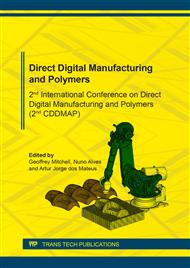[1]
S.J. Lee, J.J. Yoo , A. Atala, Biomaterials and Tissue Engineering, in: B.W. Kim (Eds.), Clinical Regenerative Medicine in Urology, Springer Singapore, Singapore, 2018, pp.17-51.
DOI: 10.1007/978-981-10-2723-9_2
Google Scholar
[2]
M. Lutolf , J. Hubbell, Synthetic biomaterials as instructive extracellular microenvironments for morphogenesis in tissue engineering, Nature biotechnology 23 (2005) 47.
DOI: 10.1038/nbt1055
Google Scholar
[3]
D.F. Williams, The Biomaterials Conundrum in Tissue Engineering, Tissue Engineering Part A 20 (2014) 1129-1131.
DOI: 10.1089/ten.tea.2013.0769
Google Scholar
[4]
D. Williams, Essential Biomaterials Science, ed., (2014).
Google Scholar
[5]
I.M. El-Sherbiny , M.H. Yacoub, Hydrogel scaffolds for tissue engineering: Progress and challenges, Global Cardiology Science and Practice (2013) 38.
DOI: 10.5339/gcsp.2013.38
Google Scholar
[6]
A. Gutowska, B. Jeong , M. Jasionowski, Injectable gels for tissue engineering, The Anatomical Record 263 (2001) 342-349.
DOI: 10.1002/ar.1115
Google Scholar
[7]
M.C. Cushing , K.S. Anseth, Hydrogel cell cultures, Science 316 (2007) 1133-1134.
DOI: 10.1126/science.1140171
Google Scholar
[8]
J.A. Killion, L.M. Geever, D.M. Devine, J.E. Kennedy , C.L. Higginbotham, Mechanical properties and thermal behaviour of PEGDMA hydrogels for potential bone regeneration application, Journal of the mechanical behavior of biomedical materials 4 (2011) 1219-1227.
DOI: 10.1016/j.jmbbm.2011.04.004
Google Scholar
[9]
S. Khalil , W. Sun, Bioprinting endothelial cells with alginate for 3D tissue constructs, Journal of biomechanical engineering 131 (2009) 111002.
DOI: 10.1115/1.3128729
Google Scholar
[10]
J. Malda, J. Visser, F.P. Melchels, T. Jüngst, W.E. Hennink, W.J. Dhert, J. Groll , D.W. Hutmacher, 25th anniversary article: engineering hydrogels for biofabrication, Advanced materials 25 (2013) 5011-5028.
DOI: 10.1002/adma.201302042
Google Scholar
[11]
J.J. Rice, M.M. Martino, L. De Laporte, F. Tortelli, P.S. Briquez , J.A. Hubbell, Engineering the regenerative microenvironment with biomaterials, Advanced healthcare materials 2 (2013) 57-71.
DOI: 10.1002/adhm.201200197
Google Scholar
[12]
K.B. Fonseca, P.L. Granja , C.C. Barrias, Engineering proteolytically-degradable artificial extracellular matrices, Progress in Polymer Science 39 (2014) 2010-2029.
DOI: 10.1016/j.progpolymsci.2014.07.003
Google Scholar
[13]
A. Skardal , A. Atala, Biomaterials for integration with 3-D bioprinting, Annals of biomedical engineering 43 (2015) 730-746.
DOI: 10.1007/s10439-014-1207-1
Google Scholar
[14]
K.T. Nguyen , J.L. West, Photopolymerizable hydrogels for tissue engineering applications, Biomaterials 23 (2002) 4307-4314.
DOI: 10.1016/s0142-9612(02)00175-8
Google Scholar
[15]
I. Mironi-Harpaz, D.Y. Wang, S. Venkatraman , D. Seliktar, Photopolymerization of cell-encapsulating hydrogels: crosslinking efficiency versus cytotoxicity, Acta biomaterialia 8 (2012) 1838-1848.
DOI: 10.1016/j.actbio.2011.12.034
Google Scholar
[16]
R.F. Pereira , P.J. Bártolo, 3D bioprinting of photocrosslinkable hydrogel constructs, Journal of Applied Polymer Science 132 (2015).
DOI: 10.1002/app.42458
Google Scholar
[17]
L.F. Zhang, R. Sun, L. Xu, J. Du, Z.C. Xiong, H.C. Chen , C.D. Xiong, Hydrophilic poly (ethylene glycol) coating on PDLLA/BCP bone scaffold for drug delivery and cell culture, Materials Science and Engineering: C 28 (2008) 141-149.
DOI: 10.1016/j.msec.2007.01.005
Google Scholar
[18]
G. Ma, D. Yang, Q. Li, K. Wang, B. Chen, J.F. Kennedy , J. Nie, Injectable hydrogels based on chitosan derivative/polyethylene glycol dimethacrylate/N, N-dimethylacrylamide as bone tissue engineering matrix, Carbohydrate Polymers 79 (2010) 620-627.
DOI: 10.1016/j.carbpol.2009.09.015
Google Scholar
[19]
V. Lucas, Controlled migration of cells on mechanically, physically and chemically patterned biomaterials, (2015).
Google Scholar


